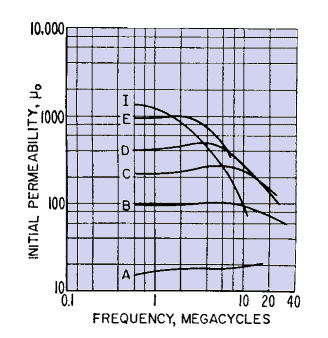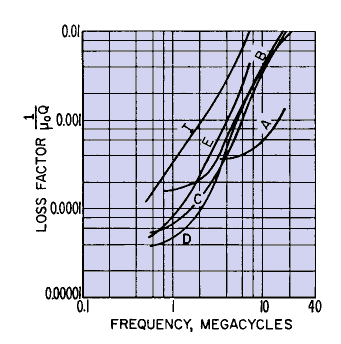| Electronic Transformers and Circuits is a free introductory textbook on transformers and related circuits. See the editorial for more information.... |

|

Home  Higher-Frequency Transformers Higher-Frequency Transformers  Other Core Materials Other Core Materials |
||||||||||||||||
| See also: New Materials | ||||||||||||||||






|
||||||||||||||||
Ferrite Cores
In the high radio-frequency bands, ferrite cores have the advantage of high resistivity and practically no eddy-current component of core loss. Several grades are manufactured commercially, usually mixtures of manganese, nickel, and zinc ferrites.
Losses in ferrites are often related to the product μ0Q. (See Fig. 165.)
This relation is approximately as follows:
Instead of μ0Q, the quantity Rser/μfL is sometimes plotted, where Rser is the equivalent series resistance corresponding to core loss. Equation 95 then becomes
At the lower radio frequencies, finely divided powdered iron has loss lower than some ferrites. Owens(1) gives 1.0 mc as the highest frequency for which this holds. Both ferrites and powdered iron have temperature limits far below that of strip-wound cores: ferrites because of low Curie temperature, and powdered iron because of possible damage to the bonding material. Powdered iron with certain bonds has the better temperature coefficient of permeability. Both materials are available in the forms shown in Fig. 144.
|
||||||||||||||||
Home  Higher-Frequency Transformers Higher-Frequency Transformers  Other Core Materials Other Core Materials |
||||||||||||||||
Last Update: 2011-02-26






